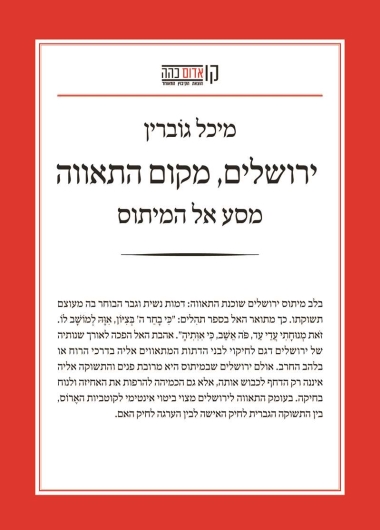At the heart of the Jerusalem myth lies passion: the figure of a woman and the man who chooses her out of the intensity of his desire. The Book of Psalms describes God thus: “For the Lord has chosen Zion, he has desired it for his dwelling: ‘This is my eternal resting place; here I will reside, for this is my desire’.” Throughout the years of Jerusalem’s existence, God’s love has become a model for emulation by those religions eager for the city, in spirit or by the sword. But the mythical Jerusalem is multi-faceted and the longing is not confined to the compulsion to conquer her, but also encompasses the yearning to loosen its hold and to rest in its bosom. The depth of the passion for Jerusalem is embodied in an intimate expression of the polarity of the Eros, between the masculine desire for the female bosom and the yearning to be nestled in the mother’s embrace.
To read and download chapters from the book (Translated by Gabriel Levin):

The journey in this book seeks to uncover the hidden facets of Jerusalem and the forgotten layers of the myths about the city as a beloved woman, betrayed and betraying, and always desired.
Over the passage of time, the passion for Jerusalem exhibited by the faithful of the three monotheistic religions has stirred up rivalry, jealousy, and wars over ownership. It is from this complex reality that Michal Govrin points out the need to acknowledge the erotic roots of the struggle over Jerusalem as a crucial element in any future solution. She assigns responsibility for the image of Jerusalem – in reality and in myth – to Judaism, which conferred on the city the foundation of its sanctity and to which it has returned as the sovereign.
Delving into the heart of the Jewish myth, Govrin proposes an alternative, revolutionary model for considering the future of the city. No ownership of one kind or another, but rather shmita in its deepest symbolic sense: the removal of fences and partitions and release from existential concerns as the highest form of sanctity and ownership. The extent of the shmita fallow detachment stems from Jerusalem itself as becomes apparent from Govrin’s eye-opening study of the primary sources, starting with the Bible, Talmudic literature, and Kaballah and through its contemporary reverberations in Israel art or political discourse; as well as from her attentive reading of the poetry of Paul Celan and the philosophy of Jacques Derida – a close interlocutor of Govrin’s who co-authored with her the non-fiction book, “Body of Prayer”.

